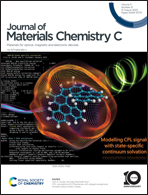Regulating multiple self-trapped exciton emissions in zero-dimensional antimony halides with pyramidal units†
Abstract
The unique photoluminescent properties of self-trapped exciton (STE) emission enable zero-dimensional hybrid metal halides (0D HMHs) to be promising luminescent materials in diverse optoelectronic applications. Especially, the pyramid units with lower structural symmetry in 0D Sb-based HMHs could facilitate multiple STE emissions from both singlet and triplet states, providing a new possibility as multifunctional emitters. However, an insightful relationship between these STE emissions and antimony halide pyramid polyhedrons is still obscure, as it is still challenging to systematically modulate their STE emissions via chemical synthesis. In this work, delicate regulation of multiple STE emissions is achieved by pressurizing and/or refrigerating the [SbCl5]2− pyramidal units in 0D (C24H20P)2SbCl5. Under ambient conditions, (C24H20P)2SbCl5 only exhibits a low-energy triplet emission. Upon compression, increased [SbCl5]2− distortions modify the STE transitions between different triplet states, and thus a new high-energy triplet emission emerges at 2.7 GPa and gradually strengthens up to 4.0 GPa. Meanwhile, the cryogenic temperature is revealed to regulate the STE emissions between singlet and triplet states in (C24H20P)2SbCl5, and the singlet emission is greatly promoted at 78 K by suppressing the thermal quenching. Furthermore, the integrated high pressure and low temperature studies prove that the enhancement of high-energy triplet emission in (C24H20P)2SbCl5 could be ascribed to the enhanced electron–phonon coupling, promoted intersystem crossing process, and restrained nonradiative transitions. This work offers a new strategy to achieve intriguing STE emissions in HMHs and also provides a deep understanding of their complex emission mechanisms.



 Please wait while we load your content...
Please wait while we load your content...